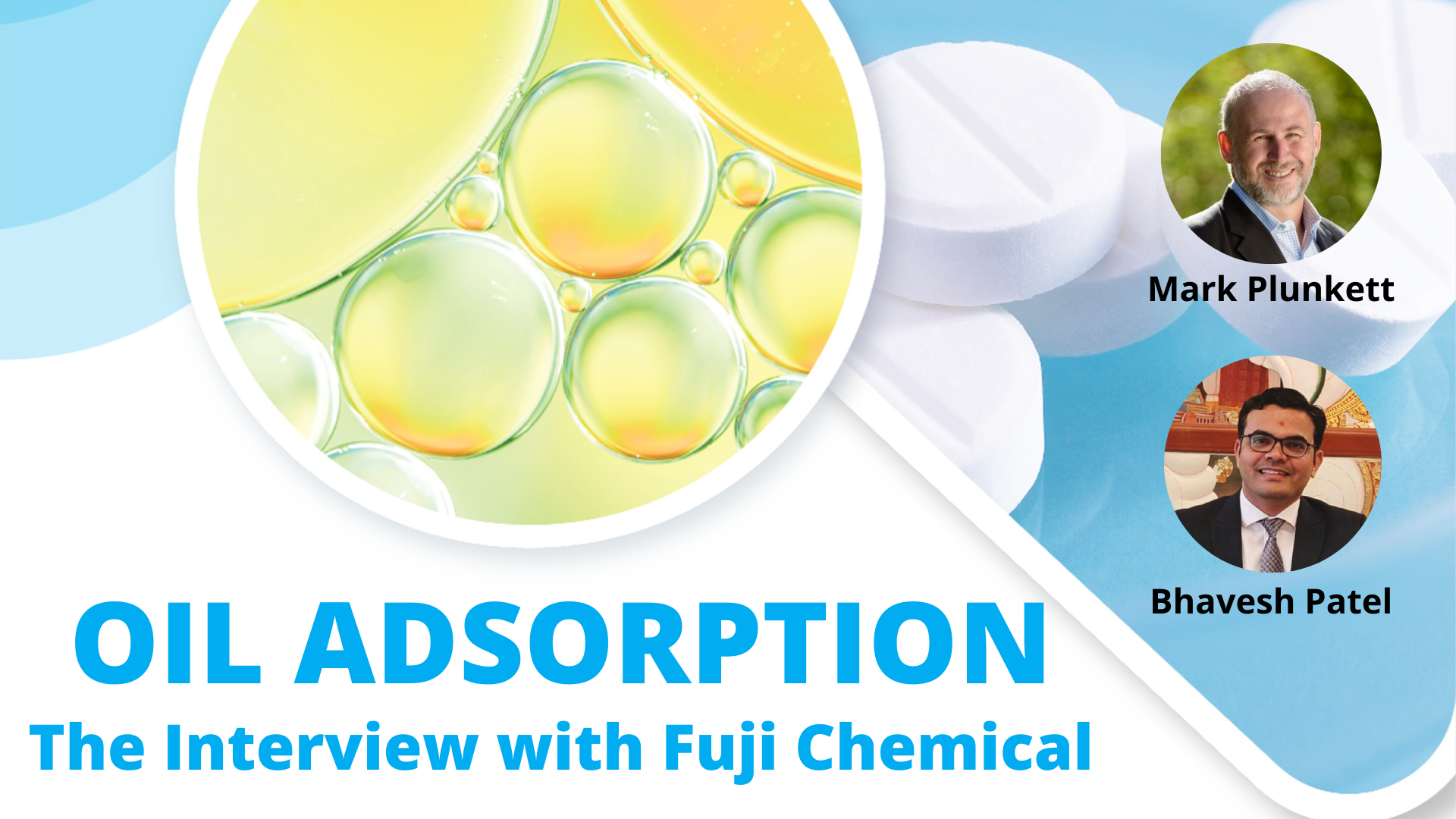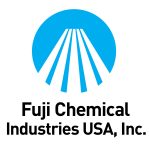Oil adsorption – The Interview with Fuji Chemical

 Fuji Chemical Industries specializes in producing porous spray-dried excipients for the pharmaceutical and nutraceutical markets. They spray-dry their excipients to produce free-flowing granules and unique internal structures that enhance compressibility and functionality. These structures are ideal to solve your formulation issues when it comes to dealing with sticky or oily API’s. Find all Fuji excipients here!
Fuji Chemical Industries specializes in producing porous spray-dried excipients for the pharmaceutical and nutraceutical markets. They spray-dry their excipients to produce free-flowing granules and unique internal structures that enhance compressibility and functionality. These structures are ideal to solve your formulation issues when it comes to dealing with sticky or oily API’s. Find all Fuji excipients here!
We took the chance and made an interview with the responsible product managers from Fuji about the best excipients for oil adsorption! Read the full transcript here.
See the full interview here:
Download the full brochure about oil adsorption here or the complete Fuji excipients brochure here!
Fuji has a large portfolio of products specifically designed for solving your oil adsorption issues. For help in choosing the correct product, please feel free to contact us or read over Fuji’s brochures. However a good starting point is always the use of Neusilin® US2 for pharmaceutical applications and Fujicalin® for nutraceutical and food applications.
Interested in a sample or more information? Click here!
Read the full transcript here:
Pharma Excipients: Good morning Pharma Excipients community. Today, we have two guests from Fuji Chemical. Mark Plunkett, Technical Marketing Manager, and Bhavesh Patel, Technical Service Manager. We are talking about Fuji solutions and tips for the best oil adsorptions. So if you’re having trouble formulating an oily API, this is an interview you need to watch. And, as always, don’t hesitate to contact us if you have more questions or need a sample. Mark, Bhavesh, thank you for being here with me today.
Mark: Thanks, Tom.
Bhavesh: Thank you, Tom.
Pharma Excipients: You’re welcome. And now let’s start with the first question. Bhavesh, why is oil adsorption such an important topic in the excipients industry?
Bhavesh: Well, it is an important topic because not all the components of solid dosage form are free flowing and simple to formulate. Many additives and API are liquid in form, some are in sticky nature, and these have adverse impact on the flowability of powder. They also affect the compressibility, as well as the tablet disintegration. So there are importance of to convert this oily API into free-flowing powder form, and it improves the performance of tablet and the finish solubilizer form.
Pharma Excipients: Can you give some examples of oily components you may want to put in tablets or powders?
Bhavesh: Sure, Tom. For example, in nutraceutical, we have active components such as essential oils, like Omega 3, some of the API such as fish oil, krill oil. So these are in oily form under nutraceutical. And in pharmaceutical also, there are few API such as Simethicone oil, vitamin D3, Tocopherol, some of the solubilizer such as Polysorbate AD, hydrogenated castor oils. So these are the list of some of the API, which are in oily form and that can be adsorb on some of the exicipient to compress into tablet and capsule.
Pharma Excipients: That sounds very reasonable, and it is a perfect transition to my next question. Because Fuji has a lot of excipients and which of them can I use for oil adsorption?
Mark: Yeah, Tom. At Fuji, we produce all of our excipients by spray drying. And as part of this process, it’s possible to create the internal porosity, and that has multiple uses including oil absorption. And we do this with a number of our products, and that includes Neusilin, Fujicalin, and FujiSil.
Pharma Excipients: All right. But, you didn’t mention F-MELT right now. Can I use it for oil adsorption or for what do I need exactly?
Mark: Yeah, Tom. I didn’t mention F-MELT, because it’s really a different product. This is a co-processed exicipient specifically designed for fast melting or fast disintegration. Typically, we use that in products like orally disintegrating tablets and chewable tablets. Strictly speaking, there is some porosity, but it’s really not ideal for this purpose, especially when you have products like Fujicalin and Neusilin, which is specifically designed for this. Of course, you can combine Fujicalin and Neusilin of the products like these with F-MELT, and then you can get the best of both worlds. So you get the oil adsorption and you can combine that with the fast disintegration and the smooth texture, the creamy mouth feel, and so on that you get with the ODT type product like F-MELT. So we get the best of both worlds.
Pharma Excipients: Good to know, that’s why. And just now you mentioned the three product families, Neusilin, Fujicalin, and FujiSil. But there are so many products. Is there any guidance you can give me?
Bhavesh: Yes. In fact, there are various factors need to be considered such as porosity, specific surface area, chemical compatibility, some of the regulatory aspects, and applications. As an example, if you’re working with pharmaceutical uses, then you can go with Neusilin, which is much higher surface area. And for porosity point of view, Neusilin would be the better option. If you’re working with nutraceutical, then you can go with Fujicalin. Apart from there, it’s also recommended to check the chemical compatibility and you can optimize based on the situation.
Pharma Excipients: That helps for sure. Thank you. Mark, what would you say are the key features of these excipients? Are there differences in use or in characteristics?
Mark: That’s a great question, Tom. I’d like to focus on three aspects here, which are key for Fuji excipients. The first is a good flowability. So we have the spray-dried granules, they’re around 100 micron in size. They have the sort of rough non-sticky surface. So these things are naturally designed for good flowability. So we have an angle of repose typically around 30 degrees so they’re great for that application.
The second real key aspect here is the high porosity. Different products have different porosity, but they all have some design to have a high porosity, and that means we can load a lot of oil. And, also, if you compress these materials into a tablet, of course, you reduce that internal porosity, but because you’re maintaining around 30% and still forming nice tablets, that means that we can still have high loadings of oil in a compressed form as well. So, both the pre and post-compression can be important depending on the application.
And the third one, which I sort of hinted on is the superior tabletability that you get with the Fuji excipients. So being able to form nice hard tablets that have low friability, you know, high quality, and that maintain that the oil concentration. So you have 30% oil in a nice hard good quality tablet, and that’s absolutely key.
Pharma Excipients: Wow, impressive. Thank you, Mark. Bhavesh, I saw in the brochure that some of your excipients loading more oil and some less. Which excipient would you recommend the most? And is loading of more oil only positive or does it come with any restrictions in another area?
Bhavesh: Interesting question, Tom. In fact, loading of more oily-API is not sufficient. You need to consider various other factors such as chemical compatibility of API with Neusilin and Fujicalin. You also want to check the in-vitro drug release rate, which is also known as the desorption rate, how fast your oil get desorbed from the surface of your excipient that you can check by in-vitro dissolution test. You have to also consider the compressibility of powder after oil adsorption, and there should be no any oil leaking issue during compression into tablet form. So these are the oil factor apart from loading of more oil respect to your to considers.
Pharma Excipients: I understand. And now I have a smaller question, but I’m curious. How exactly is the oil adsorbed and what have capillary force to do with that?
Bhavesh: Tom, this is like a capillary force and it is basically a Trigonal Phenomena. These particles are like a little sponge. If you put a sponge on to the top of water, then it sucks the water into the pores of sponge, and it is physically a capillary force.
Pharma Excipients: That’s easy to understand, and this leads directed to my next question. I heard that sometimes the surface of the excipient is oily after the adsorption. Does this also apply for Fuji excipients?
Mark: Typically no, Tom. If it is, you’re doing something wrong. Yeah, Fuji excipients really excel here, but there is two main things to remember. The first one is that this is a dynamic event. It takes time for an oil to absorb in. So sometimes you need to give the oil time to absorb in, and that comes down to viscosity. If your viscosity is too high that may mean that the dynamics are very slow, which could lead to a problem. If that’s the case, you need to speed it up. Of course, you can reduce the viscosity. You know, temperature or solvents will solve that. And the second is don’t overload.
Pharma Excipients: Thanks, Mark. Good to know. But now, I’m going a little different direction or area, like with which pressure can I press the tablets?
Bhavesh: Sure, Tom. Here, I would like to say the key aspect is the tablet hardness. Since compression pressure usually varies with respect to different systems. So let me give you at least two examples. In general, we suggest a compression of tablet at lower range of 40-Newton hardness and higher range of 50-Newton hardness to achieve the better functionality of tablet with minimum oil losing from the tablet surface.
Pharma Excipients: Thanks a lot, Bhavesh. And now last but for sure not least, what are the benefits of your products in comparison with competitors?
Mark: Yeah, Tom. Fuji products are specifically designed for oil adsorption, that’s really the key aspect here. And it comes down to a number of different reasons for that. The first one is our products have good flowability. The spray-dry process that we talked about earlier means we have good flowability, and that’s critical for manufacturing and product use.
The second is the high porosity. Because we have high porosity in our products, they’re good for using in oil absorption. And that’s both pre and post-compression as I talked about earlier. The third point I’d like to raise is good tabletability. We’ve got to be able to make hard high quality tablets, and these excipients are specifically engineered to do that.
The next point that we wanna talk about is regulatory and Bhavesh introduced that a little bit earlier. We’ve got to be able to have the right regulatory compliance for the product. The fifth point was also raised by Bhavesh which is the adsorption and release rates. And here being able to optimize the interaction between the particular component and the excipient in question is really, really key. And having multiple chemistry options is really key. And that’s something that we focused on in terms of being able to do this.
So, in summary, we have a range of products specifically designed for oil adsorption and these products can all give high quality end-products for you as our customers.
- Flowability
- High porousity
- Tabletability
- Regulatory
- Adsorption and release rates
- Multiple chemistry options
Pharma Excipients: Thanks a lot for the answer, Mark. Thanks for this exciting interview you two. I learned a lot of interesting facts today, and I hope our users too! Bhavesh, Mark, thanks again for your time.
Mark: Thank you very much, Tom.
Bhavesh: Thank you, Tom.
Pharma Excipients: You’re welcome, and have a good day. Bye-bye.

